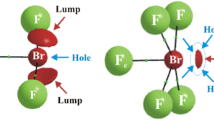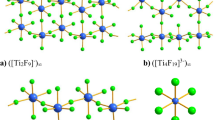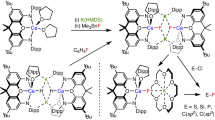Abstract
Context
The reaction between Na and HF is a typical harpooning reaction which is of great interest due to its significance in understanding the elementary chemical reaction kinetics. This work aims to investigate the detailed reaction mechanisms of sodium with hydrogen fluoride and the adsorption of HF on the resultant NaF as well as the (NaF)4 tetramer. The results suggest that the reaction between Na and HF leads to the formation of sodium fluoride salt NaF and hydrogen gas. Na interacts with HF to form a complex HF···Na, and then the approaching of F atom of HF to Na results in a transition state H···F···Na. Accompanied by the broken of H-F bond, the bond forms between F and Na atoms as NaF, then the product NaF is yielded due to the removal of H atom. The resultant NaF can further form (NaF)4 tetramer. The interaction of NaF with HF leads to the complex NaF···HF; the form I as well as II of (NaF)4 can interact with HF to produce two complexes (i.e., (NaF)4(I-1)···HF, (NaF)4(I-2)···HF, (NaF)4(II-1)···HF and (NaF)4(II-2)···HF), but the form III of (NaF)4 can interact with HF to produce only one complex (NaF)4(III)···HF. These complexes were explored in terms of noncovalent interaction (NCI) and quantum theory of atoms in molecules (QTAIM) analyses. NCI analyses confirm the existences of attractive interactions in the complexes HF···Na, NaF···HF, (NaF)4(I-1)···HF, (NaF)4(I-2)···HF, (NaF)4(II-1)···HF and (NaF)4(II-2)···HF, and (NaF)4(III)···HF. QTAIM analyses suggest that the F···Na interaction forms in the HF···Na complex while the F···H hydrogen bonds form in NaF···HF, (NaF)4(I-1)···HF, (NaF)4(I-2)···HF, (NaF)4(II-1)···HF and (NaF)4(II-2)···HF, and (NaF)4(III)···HF complexes. Natural bond orbital (NBO) analyses were also applied to analyze the intermolecular donor-acceptor orbital interactions in these complexes. These results would provide valuable insight into the chemical reaction of Na and HF and the adsorption interaction between sodium fluoride salt and HF.
Methods
The calculations were carried out at the M06-L/6-311++G(2d,2p) level of theory which were performed using the Gaussian16 program. Intrinsic reaction coordinate (IRC) calculations were carried out at the same level of theory to confirm that the obtained transition state was true. The molecular surface electrostatic potential (MSEP) was employed to understand how the complex forms. Quantum theory of atoms in molecules (QTAIM) and noncovalent interaction (NCI) analysis was used to know the topology parameters at bond critical points (BCPs) and intermolecular interactions in the complex and intermediate. The topology parameters and the BCP plots were obtained by the Multiwfn software.












Similar content being viewed by others
References
Yan W, Tan RS, Lin SY (2023) New ab initio potential energy surface of NaFH (1A′) system and quantum dynamics studies for the Na + HF (v, j) / NaF + H reaction. RSC Adv 13:15506–15513
Chang XY, Ehlich R, Hudson AJ, Piecuch P, Polanyi JC (1997) Dynamics of harpooning studied by transition state spectroscopy Na...FH. Faraday Discuss 108:411–425
Herschbach DR (1966) Reactive scattering in molecular beams. Adv Chem Phys 10:319–393
Antunes AWS, Ferreira Da Cunha W, Silva G ME, Martins JB, Gargano R (2010) Dynamical properties and thermal rate coefficients for the Na + HF reaction using genetic algorithm. Int J Quantum Chem 110:1070–1079
Bartoszek FE, Blackwell BA, Polanyi JC, Sloan JJ (1981) Effect of changing reagent energy on reaction dynamics. XI. Dependence of Reaction Rate on Vibrational Excitation in Endothermic Reactions HX (vreag)+ Na→H+NaX (X≡ F, Cl). J Chem Phys 74:3400–3410
Blackwell BA, Polanyi JC, Sloan JJ (1978) Effect of changing reagent energy. IX. Dependence of Reaction Rate on Rotational Excitation in HX(J:ν) + Na → H + NaX (X = F, Cl). Chem Phys 30:299–306
Düren R, Lackschewitz U, Milosevic S (1988) Reactive scattering of sodium and hydrogen fluoride evolving on an electronically excited surface. Chem Phys 126:81–91
Düren R, Lackschewitz U, Milosevic S, Panknin H, Schirawski N (1988) Differential cross sections for reactive and non-reactive scattering of electronically excited Na from HF molecules. Chem Phys Lett 143:45–50
Düren R, Lackschewitz U, Milosevic S, Waldapfel HJ (1989) Differential scattering of Na(3P) from HF. reactive and non-reactive processes. J Chem Soc, Faraday Trans 2(85):1017–1025
Espinola Lopez LE, Gargano R, Mundim KC, Soares Neto JJ (2002) The Na + HF reactive probabilities calculations using two different potential energy surfaces. Chem Phys Lett 361:271–276
Ferreira Da Cunha W, Roncaratti LF, Gargano R, Silva GME (2006) Fitting potential energy surface of reactive systems via genetic algorithm. Int J Quantum Chem 106:2650–2657
Garashchuk S, Rassolov VA (2007) Semiclassical nonadiabatic dynamics of NaFH with quantum trajectories. Chem Phys Lett 446:395–400
Gargano R, Crocchianti S, Lagana A, Parker GA (1998) The quantum threshold behavior of the Na + HF Reaction. J Chem Phys 108:6266–6271
Jasper AW, Truhlar DG (2007) Non-Born-Oppenheimer molecular dynamics of Na···FH photodissociation. J Chem Phys 127:194306
Katz G, Zeiri Y, Kosloff R (2002) Three-dimensional quantum time-dependent study of the photodissociation dynamics of Na···FH/D. Chem Phys Lett 359:453–459
Lagana A, Alvariño JM, Hernandez ML, Palmieri P, Garcia E, Martinez T (1997) Ab initio calculations and dynamical tests of a potential energy surface for the Na + FH reaction. J Chem Phys 106:10222–10229
Paniagua M, Garcia De La Vega JM, Alvarez Collado JR, Sanz JC, Alvariño JM, Lagana A (1986) RHF potential energy surface for the collinear reaction of Na with HF. J Mol Struct 142:525–528
Sevin A, Hiberty PCL, J. M. (1987) Theoretical study of the ground- and excited-state reactivity of sodium and hydrogen fluoride. Comparison of SCF-CI and VB Treatments. J Am Chem Soc 109:1845–1852
Shapiro M, Zeiri Y (1979) Semiempirical potential surfaces for the alkali hydrogen-halide reactions. J Chem Phys 79:5264–5270
Spirko V, Piecuch P, Bludsky O (2000) Bound and quasibound states of the Na···FH Van der Waals Molecule. J Chem Phys 112:189–202
Topaler MS, Truhlar DG, Chang XY, Piecuch P, Polanyi JC (1998) Potential energy surfaces of NaFH. J Chem Phys 108:5349–5377
Vilela AFA, Soares Neto JJ, Mundim KC, Mundim KC, Gargano R (2002) Fitting potential energy surface for reactive scattering dynamics through generalized simulated annealing. Chem Phys Lett 359:420–427
Wang D, Shi G, Fu L, Yin R, Ji Y (2019) Accurate potential energy surfaces for the three lowest electronic states of N(2D)+H2(X1 ) scattering reaction. ACS Omega 4:12167–12174
Weiss PS, Mestdagh JM, Covinsky MH, Balko BA, Lee YT (1988) The reactions of ground and excited state sodium atoms with hydrogen halide molecules. Chem Phys 126:93–109
Yan W, Tan RS, Lin SY (2019) Quantum dynamics calculations of Na (32S, 32P) + HF → NaF + H reactions. J Phys Chem A 123:2601–2609
Yin R, Gao N, Cao J, Li Y, Wang D, Huang X (2020) Global accurate diabatic potential surfaces for the reaction H + Li2. RSC Adv 10:39226–39240
Yin R, Gao N, Zhang R, Wang D, Huang X (2020) Accurate potential energy surfaces for the excited state of CF2 molecule. Chem Phys 538:110906
Zeiri Y, Katz G, Kosloff R, Topaler MS, Truhlar DG, Polanyi JC (1999) Quantum mechanism in the photodissociation of NaFH complex: a challenge to semiclassical analysis. Chem Phys Lett 300:523–528
Espinosa E, Lecomte C, Ghermani NE, Devemy J, Rohmer MM, Bernard M et al (1996) Hydrogen bonds: first quantitative agreement between electrostatic potential calculations from experimental X−(X + N) and theoretical ab initio SCF models. J Am Chem Soc 118:2501–2502
Jasper AW, Hack MD, Chakraborty A, Truhlar DG, Piecuch P (2001) Photodissociation of LiFH and NaFH Van der Waals complexes: a semiclassical trajectory study. J Chem Phys 115:7945–7952
Topaler MS, Truhlar DG, Chang XY, Piecuch P, Polanyi JC (1998) The photoabsorption spectrum of Na···FH Van der Waals molecule: comparison of theory and experiment for a harpooning reaction studied by transition state spectroscopy. J Chem Phys 108:5378–5390
Yan W, Tan RS, Lin SY (2019) Quantum dynamics studies of the Na(3S)+HF and Na(3S/3P)+DF reactions: the effects of the initial rotational excitation and the isotopic substitution. Chem Phys Lett 730:378–383
Hargittai M (2000) Molecular structure of metal halides. Chem Rev 100:2233–2301
Aguado A, Ayuela A, Lopez JM, Alonso JA (1997) Structure and bonding in small neutral alkali halide clusters. Phys Rev B 56:15353
Bickelhaupt FM, Sola M, Guerra CF (2007) Covalent versus ionic bonding in alkalimetal fluoride oligomers. J Comput Chem 28:238–250
Lintuluoto M (2001) Theoretical study on the structure and energetics of alkali halide clusters. J Mol Struct (THEOCHEM) 540:177
Zhao Y, Truhlar DG (2006) A new local density functional for main-group thermochemistry, transition metal bonding, thermochemical kinetics, and noncovalent interactions. J Chem Phys 125:194101
Zhao Y, Truhlar DG (2008) The M06 suite of density functionals for main group thermochemistry, thermochemical kinetics, noncovalent interactions, excited states, and transition elements: two new functionals and systematic testing of four M06-class functionals and 12 other functionals. Theor Chem Accounts 120:215–241
Grimme S, Antony J, Ehrlich S, Krieg H (2010) A consistent and accurate ab initio parametrization of density functional dispersion correction (DFT-D) for the 94 elements H-Pu. J Chem Phys 132:154104
Fukui K (1981) The path of chemical reactions-the IRC approach. Acc Chem Res 14:363–368
Frisch MJ, Trucks GW, Schlegel HB, Scuseria GE, Robb MA, Cheeseman JR et al (2016) Gaussian 16, revision A.03Revision A.03 edn. Gaussian, Inc, Wallingford, CT
Dimitrova V, Ilieva S, Galabov B (2002) Electrostatic potential at atomic sites as a reactivity descriptor for hydrogen bonding. Complexes of Monosubstituted Acetylenes and Ammonia. J Phys Chem A 106:11801–11805
Duarte DJR, de las Vallejos MM, Peruchena NM (2010) Topological analysis of aromatic halogen/hydrogen bonds by electron charge density and electrostatic potentials. J Mol Model 16:737–748
Galabov B, Bobadova-Parvanova P (1999) Molecular electrostatic potential as reactivity index in hydrogen bonding: ab initio molecular orbital study of complexes of nitrile and carbonyl compounds with hydrogen fluoride. J Phys Chem A 103:6793–6799
Kenny PW (2009) Hydrogen bonding, electrostatic potential and molecular design. J Chem Inf Model 49:1234–1244
Politzer P, Murray JS, Concha MC (2007) Halogen bonding and the design of new materials: organic bromides, chlorides and perhaps even fluorides as donors. J Mol Model 13:643–650
Bader RFW (1985) Atoms in molecules. Acc Chem Res 18:9–15
Bader RFW (1990) Atoms in molecules: a quantum theory. Oxford University Press, Oxford, UK
Bader RFW (1991) A quantum theory of molecular structure and its applications. Chem Rev 91:893–928
Contreras-García J, Johnson ER, Keinan S, Chaudret R, Piquemal J-P, Beratan DN et al (2011) NCIPLOT: a program for plotting noncovalent interaction regions. J Chem Theory Comput 7:625–632
Johnson ER, Keinan S, Mori-Sánchez P, Contreras-García J, Cohen AJ, Yang W (2010) Revealing noncovalent interactions. J Am Chem Soc 132:6498–6506
Lu T, Chen F (2012) Multiwfn: a multifunctional wavefunction analyzer. J Comput Chem 33:580–592
Lipkowski P, Grabowski SJ, Robinson TL, Leszczynski J (2004) Properties of the C-H···H dihydrogen bond: an ab initio and topological analysis. J Phys Chem A 108:10865–10872
Arnold WD, Oldfied E (2000) The chemical nature of hydrogen bonding in proteins via NMR: J-Couplings, Chemical Shifts, and AIM Theory. J Am Chem Soc 122:12835–12841
Reed AE, Weinstock RB, Weinhold F (1985) Natural population analysis. J Chem Phys 83:735–746
Reed AE, Curtiss LA, Weinhold F (1988) Intermolecular interactions from a natural bond orbital, donor-acceptor viewpoint. Chem Rev 88:899–926
Funding
This research was supported by the Open and Cooperation Innovation Fund from Xi’an Modern Chemistry Research Institute and the Fundamental Research Funds for the Central Universities under Grant No. lzujbky-2021-sp43.
Author information
Authors and Affiliations
Contributions
QY, JY, and P-PZ: data analysis, writing—review and editing; H-RZ, P-YL, GG, YY, and WD: data analysis and discussion; P-YL and H-RZ: calculations and data collection
Corresponding authors
Ethics declarations
Conflict of interest
The authors declare no competing interests.
Additional information
Publisher’s note
Springer Nature remains neutral with regard to jurisdictional claims in published maps and institutional affiliations.
Supplementary information
ESM 1
(DOC 51 kb)
Rights and permissions
Springer Nature or its licensor (e.g. a society or other partner) holds exclusive rights to this article under a publishing agreement with the author(s) or other rightsholder(s); author self-archiving of the accepted manuscript version of this article is solely governed by the terms of such publishing agreement and applicable law.
About this article
Cite this article
Yu, Q., Yang, J., Zhang, HR. et al. Investigations of the reaction mechanism of sodium with hydrogen fluoride to form sodium fluoride and the adsorption of hydrogen fluoride on sodium fluoride monomer and tetramer. J Mol Model 30, 26 (2024). https://doi.org/10.1007/s00894-023-05821-z
Received:
Accepted:
Published:
DOI: https://doi.org/10.1007/s00894-023-05821-z




